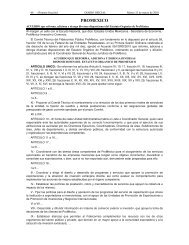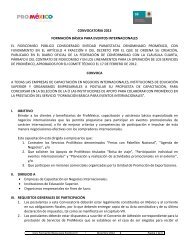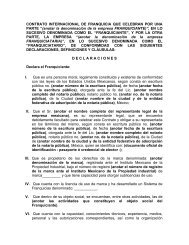mexico renews itself - ProMéxico
mexico renews itself - ProMéxico
mexico renews itself - ProMéxico
You also want an ePaper? Increase the reach of your titles
YUMPU automatically turns print PDFs into web optimized ePapers that Google loves.
26 Negocios ProMéxico Negocios ProMéxico 27<br />
In Search<br />
of the<br />
Perfect Storm<br />
México Power Group is propelling radical change in the energy<br />
industry. After sweeping in on northern winds, its turbines now spin<br />
in the far south.<br />
____<br />
by omar magaña<br />
photo courtesy of cannon power group<br />
The Law for the Exploitation of Renewable Energies and<br />
Financing of the Energy Transition (LAERFTE) was the<br />
spark that ignited a new and sprightly industry in Mexico.<br />
Announced in 2009 by the Ministry of Energy (SENER),<br />
the new law invites the private sector to participate in mechanisms<br />
for the planned, sustainable consumption and generation of nonfossil-fuel<br />
energy, i.e. energy obtained from renewable sources such<br />
as the wind, sun, water and biomass.<br />
This broadened the horizons of Cannon Power Group, a California-based<br />
company specializing in wind farms that had previously<br />
been restricted to exporting the electricity generated by La Rumorosa<br />
wind farm, in Tecate, Baja California to the US. Now it is free to<br />
sell the energy it generates in Mexico on the domestic market, and<br />
what better incentive to increase production capacity.<br />
Cannon Power Group and its partner, Coram Energy Corporation,<br />
both have 30 years’ experience in the development of wind<br />
projects worldwide. In July 2011, they decided to grant their Mexican<br />
office greater autonomy. The result was the founding of a new<br />
company –México Power Group– with John Prock as CEO.<br />
“The new legislation introduced by the Mexican government<br />
changed our approach and outlook. Now it makes more sense for us<br />
to supply companies and government entities here in Mexico with<br />
our green energy,” says Prock.<br />
México Power Group had barely incorporated when its board<br />
chairman, Gerald Monkhouse (also board chairman of Cannon<br />
Power Group), president Brian O’Sullivan and CEO John Prock<br />
announced their first major investment in Mexico: 2.5 billion usd<br />
for the construction of three wind farms –one in Baja California,<br />
a second in Zacatecas and a third in Quintana Roo– which will<br />
produce a total of 312 megawatts (MW) during their first phase<br />
of operations.<br />
The Promised Land<br />
The sheer magnitude of this outlay by México Power Group indicates<br />
the course Mexico is taking as the second-largest recipient<br />
of investment in the wind energy sector in Latin America, outdone<br />
only by Brazil, which has embarked on a race to cover the entire<br />
country with turbines.<br />
According to studies conducted by the industry worldwide, all<br />
both countries were lacking was a regulatory framework to clarify<br />
the rules for private sector participation in the generation and<br />
transmission of clean electricity.<br />
As such, LAERFTE constitutes a huge step forward for Mexico,<br />
by defining mechanisms for the transmission of wind-generated<br />
and other renewable sources of electricity via the Federal Electricity<br />
Commission (CFE) grid, and generation models that allow for<br />
private sector participation.<br />
In its 2011 Global Wind Report, the Global Wind Energy<br />
Council (GWEC) mentions some of the most significant changes<br />
that took place in Mexico in that year: new transmission points<br />
were installed in Oaxaca –Mexico’s windiest state–, the price<br />
of turbines fell, leading wind generator developers (Acciona,<br />
Vestas, Gamesa and Clipper) entered the domestic market and<br />
financing became more available.<br />
Meanwhile, SENER is seeking to promote the generation of<br />
clean electricity and a gradual reduction in transmission costs by<br />
developing new interconnection models and entering into agreements<br />
with generators.<br />
It was back in 2010 when Mexico set <strong>itself</strong> the goal of increasing<br />
its total installed capacity for wind-generated electricity in a very<br />
short timeframe. That year, 316 MW were added to extant output at<br />
wind farms in Oaxaca and a handful of other sites around the country,<br />
closing the year at 519 MW. By 2011, this figure had risen to 873<br />
MW and in all likelihood will have reached 1 gigawatt (GW) by the<br />
time you read this, putting the country well on track to its goal of 3.5<br />
GW by year-end 2015.<br />
Baja California, Where the<br />
Winds of Change Blow<br />
A large portion of investment in Mexico’s wind energy industry<br />
ends up in Baja California, specifically the mountainous areas of the<br />
Sierra de Juárez, on the Mexico-US border.<br />
This is where the strongest winds and the largest projects can<br />
be found, each with an estimated production capacity of 1,000 MW.<br />
“Cannon Power Group has been keeping a close eye on this area<br />
for the last 16 years, and began working closely with communities<br />
in the vicinity of La Rumorosa as far back as 2006, with a view to<br />
exporting electricity to the US,” says Prock.<br />
In 2007, the company sold a 250-MW generation project to<br />
Sempra Generation under a co-development agreement in the community<br />
of Jacume, in the middle of the Sierra de Juárez. A year later,<br />
it purchased an additional 20,000 hectares in the area, according to<br />
information published on its website.<br />
In July 2011, Cannon Power<br />
Group and Coram Energy<br />
Corporation decided to grant<br />
their Mexican office greater<br />
autonomy. The result was<br />
México Power Group.<br />
Then, in 2010, Cannon Power Group entered into an alliance<br />
with wind-generator manufacturer Gamesa, to build a 32,000-hectare<br />
wind farm in Aubanel Vallejo, which is currently managed by<br />
México Power Group. During the first phase of the project, México<br />
Power Group will occupy only 750 hectares and will produce 72<br />
MW, although total capacity is estimated at 1 GW.<br />
“We are waiting for the perfect storm, a situation in which the<br />
natural resource –the wind–, transmission lines at our disposal and<br />
customers for the electricity we generate come together,” says Prock.<br />
México Power Group is still negotiating permits for its project in<br />
Baja California, under which it will export electricity, supply crossborder<br />
assembly plants and provide street lighting for the municipalities<br />
of Tecate, Rosarito, Ensenada and Tijuana.<br />
Substantial progress has also been made on the other two sites<br />
covered by the investment announced in 2011. During an initial phase,<br />
60 MW will be generated on 3,400 of the 6,000 hectares the company<br />
owns on the island of Cozumel in Quintana Roo, and another 180 MW<br />
on 1,500 of the 6,500 hectares it owns in La Bufa, Zacatecas.<br />
Trees and Turbines<br />
As Far As the Eye Can See<br />
Even when renewable energies represent an a priori green alternative<br />
to fossil fuels, companies like México Power Group need to<br />
ensure their activities have a minimal impact on the environment<br />
and wildlife habitats.<br />
“Since green energy is our only business, we want to protect the<br />
environment. The impact on the land is less than 2%; if it is common<br />
land or is being used for something else, it can still be used for<br />
that purpose,” says Prock, adding that during the first phase of the<br />
Aubanel Vallejo project in Baja California, the company will pay 1<br />
million usd a year for usufruct of the land where the wind turbines<br />
are to be installed, even though they will not necessarily interfere<br />
with the land’s current use.<br />
In response to concerns voiced by environmentalists about<br />
the impact on birdlife, Prock said that the turbines México Power<br />
Group plans to install are fitted with new generation rotor blades<br />
that have a larger diameter and are just as effective at capturing<br />
wind energy, but that spin at a reduced speed of 15 revolutions per<br />
minute (rpm) and are therefore less disruptive to birds.<br />
Prock is confident Mexico will continue to make progress<br />
on the legislative front. And as a pioneering force in the energy<br />
revolution that’s already on its doorstep, México Power Group<br />
hopes this progress will eventually afford private sector players<br />
greater freedom to generate and sell electricity without the need<br />
for a middleman. n<br />
www.<strong>mexico</strong>powergroup.com

















